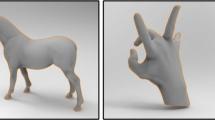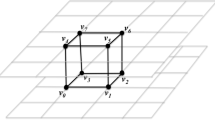Abstract
Marching Cubes based iso-surface extraction is widely used for data visualization. However, the increasing size of volume sets has made extracted iso-surfaces difficult to manipulate, and applying out-of-core simplification on them is considerably slow. We present an on-the-fly simplification algorithm for out-of-core iso-surfaces generated by Marching Cubes based extraction. Our algorithm shifts between extraction and decimation during the processing of volume sets, and never stores the entire extracted iso-surface in the main memory. The key of our algorithm is that we exploit the extraction pattern of Marching Cubes to determine when the mesh operator can be applied on certain generated vertices. This enables the decimation to be applied after any specified number of triangles are extracted. It also provides a framework for on-the-fly processing of large iso-surfaces. Our algorithm is more efficient than cascading out-of-core extraction and simplification, while providing high simplification quality comparable to in-core algorithms.
Graphical abstract










Similar content being viewed by others
References
Akio D, Koide A (1991) An efficient method of triangulating equi-valued surfaces by using tetrahedral cells. IEICE Trans Inf Syst 74(1):214–224
Attali D, Cohen-Steiner D, Edelsbrunner H (2005) Extraction and simplification of iso-surfaces in tandem. In: Eurographics symposium on geometry processing 2005, The Eurographics Association, pp 139–148
Bernardini F, Rushmeier H, Martin IM, Mittleman J, Taubin G (2002) Building a digital model of michelangelo’s florentine pieta. Comput Gr Appl IEEE 22(1):59–67
Brodsky D, Pedersen JB, (2003) A parallel framework for simplification of massive meshes. In: Parallel and large-data visualization and graphics (2003) PVG 2003. IEEE symposium on, IEEE, pp 17–24
Cignoni P, Rocchini C, Scopigno R (1998) Metro: measuring error on simplified surfaces. Comput Gr Forum, Wiley Online Libr 17:167–174
Cignoni P, Montani C, Rocchini C, Scopigno R (2003) External memory management and simplification of huge meshes. Vis Comput Gr IEEE Trans 9(4):525–537
Garland M, Heckbert PS (1997) Surface simplification using quadric error metrics. In: Proceedings of the 24th annual conference on computer graphics and interactive techniques, ACM Press/Addison-Wesley Publishing Co., pp 209–216
Hoppe H (1996) Progressive meshes. In: Proceedings of the 23rd annual conference on computer graphics and interactive techniques, ACM, pp 99–108
Isenburg M, Lindstrom P (2005) Streaming meshes. In: Visualization (2005) VIS 05. IEEE, IEEE, pp 231–238
Isenburg M, Lindstrom P, Gumhold S, Snoeyink J (2003) Large mesh simplification using processing sequences. In: Proceedings of the 14th IEEE visualization 2003 (VIS’03), IEEE computer society, p 61
Ju T, Losasso F, Schaefer S, Warren J (2002) Dual contouring of hermite data. In: ACM Transactions on Graphics (TOG) - Proceedings of ACM SIGGRAPH 2002, ACM, NY, USA, vol 21, pp 339–346
Lindstrom P (2000) Out-of-core simplification of large polygonal models. In: Proceedings of the 27th annual conference on computer graphics and interactive techniques, ACM Press/Addison-Wesley Publishing Co., pp 259–262
Lindstrom P, Silva CT (2001) A memory insensitive technique for large model simplification. In: Proceedings of the conference on visualization’01, IEEE computer society, pp 121–126
Lorensen WE, Cline HE (1987) Marching cubes: a high resolution 3D surface construction algorithm. ACM Siggr Comput Gr ACM 21:163–169
Manson J, Schaefer S (2010) Isosurfaces over simplicial partitions of multiresolution grids. Comput Gr Forum, Wiley Online Libr 29:377–385
Newman TS, Yi H (2006) A survey of the marching cubes algorithm. Comput Gr 30(5):854–879
Nielson GM, Hamann B (1991) The asymptotic decider: resolving the ambiguity in marching cubes. In: Proceedings of the 2nd conference on visualization’91, IEEE Computer Society Press, pp 83–91
Peng Y, Chen L, Yong JH (2014) Importance-driven isosurface decimation for visualization of large simulation data based on openCL. Comput Sci Eng 16(1):24–32
Prince C (2000) Progressive meshes for large models of arbitrary topology. Master’s thesis, University of Washington
Rossignac J, Borrel P (1993) Multi-resolution 3D approximations for rendering complex scenes. Springer, Berlin
Schaefer S, Warren J (2005) Dual marching cubes: primal contouring of dual grids. Comput Gr Forum, Wiley Online Libr 24:195–201
Schroeder WJ, Zarge JA, Lorensen WE (1992) Decimation of triangle meshes. ACM Siggr Comput Gr ACM 26:65–70
Shirley P, Tuchman A (1990) A polygonal approximation to direct scalar volume rendering. In: Proceedings of the 1990 Workshop on Volume Visualization, ACM, NY, USA, vol 24, pp 63–70. http://doi.acm.org/10.1145/99307.99322
Van Gelder A, Wilhelms J (1994) Topological considerations in isosurface generation. ACM Trans Gr (TOG) 13(4):337–375
Wu J, Kobbelt L (2003) A stream algorithm for the decimation of massive meshes. Gr Interface 3:185–192
Acknowledgments
This work was supported in part by the National Natural Science Foundation of China (61272225, 61572274, 91515103, 51261120376). We would like to thank the Stanford Computer Graphics Laboratory for the bunny dataset, http://www.volvis.org web site for the foot and teapot datasets, and Michael Garland for providing the QSlim implementation.
Author information
Authors and Affiliations
Corresponding author
Additional information
This work was supported in part by the National Science Foundation of China (61272225, 61572274, 91515103, 51261120376).
Rights and permissions
About this article
Cite this article
Hou, T., Chen, L. On-the-fly simplification of large iso-surfaces with per-cube vertex modifiability detection. J Vis 19, 715–726 (2016). https://doi.org/10.1007/s12650-016-0359-5
Received:
Revised:
Accepted:
Published:
Issue Date:
DOI: https://doi.org/10.1007/s12650-016-0359-5




